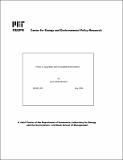| dc.contributor.author | Montero, Juan-Pablo | en_US |
| dc.contributor.other | Massachusetts Institute of Technology. Center for Energy and Environmental Policy Research. | en_US |
| dc.date.accessioned | 2009-04-03T17:08:35Z | |
| dc.date.available | 2009-04-03T17:08:35Z | |
| dc.date.issued | 1999 | en_US |
| dc.identifier | 99009 | en_US |
| dc.identifier.uri | http://hdl.handle.net/1721.1/45094 | |
| dc.description.abstract | This paper extends Weitzman's (1974) "Prices vs. Quantities" to allow for incomplete enforcement. Whether the regulator uses prices (e.g., taxes) or quantities (e.g., tradeable quotas), a first-best design is always inefficient in the presence of incomplete enforcement. A second-best design that incorporates incomplete enforcement, and where cost and benefit curves are known with certainty, can be implemented equally well with either instrument. If benefit and cost curves are uncertain, however, a quantity instrument performs better than a price instrument. In fact, if the slopes of the marginal cost and marginal benefit curves are equal, quantities are always preferred over prices. Results are consistent to alternative enforcement policies. | en_US |
| dc.description.sponsorship | Supported by the MIT Center for Energy and Environmental Policy Research. | en_US |
| dc.format.extent | 28 p | en_US |
| dc.publisher | MIT Center for Energy and Environmental Policy Research | en_US |
| dc.relation.ispartofseries | MIT-CEEPR (Series) ; 99-009WP. | en_US |
| dc.title | Prices vs. quantities with incomplete enforcement | en_US |
| dc.type | Working Paper | en_US |
| dc.identifier.oclc | 52331281 | en_US |
